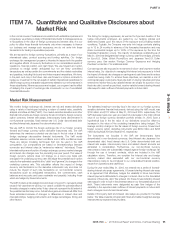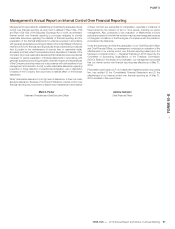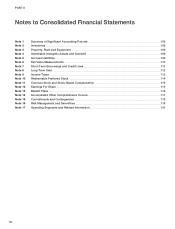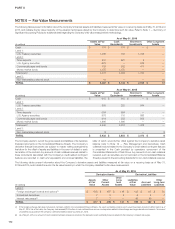Nike 2016 Annual Report Download - page 52
Download and view the complete annual report
Please find page 52 of the 2016 Nike annual report below. You can navigate through the pages in the report by either clicking on the pages listed below, or by using the keyword search tool below to find specific information within the annual report.
PART II
NOTE 1 — Summary of Significant Accounting Policies
Description of Business
NIKE, Inc. is a worldwide leader in the design, development and worldwide
marketing and selling of athletic footwear, apparel, equipment, accessories
and services. NIKE, Inc. portfolio brands include the NIKE Brand, Jordan
Brand, Hurley and Converse. The NIKE Brand is focused on performance
athletic footwear, apparel, equipment, accessories and services across a
wide range of sport categories, amplified with sport-inspired sportswear
products carrying the Swoosh trademark as well as other NIKE Brand
trademarks. The Jordan Brand is focused on athletic and casual footwear,
apparel and accessories, using the Jumpman trademark. Sales of Jordan
Brand products are reported as a separate category within the respective
NIKE Brand geographic operating segments. The Hurley brand is focused on
surf and action sports and youth lifestyle footwear, apparel and accessories,
using the Hurley trademark. Sales of Hurley brand products are included
within the NIKE Brand Action Sports category and within the NIKE Brand’s
North America geographic operating segment, respectively. Converse
designs, distributes, markets and sells casual sneakers, apparel and
accessories under the Converse, Chuck Taylor, All Star, One Star, Star
Chevron and Jack Purcell trademarks. In some markets outside the U.S.,
these trademarks are licensed to third parties who design, distribute, market
and sell similar products. Operating results of the Converse brand are
reported on a stand-alone basis.
Basis of Consolidation
The Consolidated Financial Statements include the accounts of NIKE, Inc.
and its subsidiaries (the “Company”). All significant intercompany transactions
and balances have been eliminated.
On November 19, 2015, the Company announced a two-for-one split of both
NIKE Class A and Class B Common Stock. The stock split was in the form of
a 100 percent stock dividend payable on December 23, 2015 to shareholders
of record at the close of business on December 9, 2015. Common stock
began trading at the split-adjusted price on December 24, 2015. All share and
per share amounts presented reflect the stock split.
Reclassifications
Certain prior year amounts have been reclassified to conform to fiscal 2016
presentation.
Revenue Recognition
Wholesale revenues are recognized when title and the risks and rewards of
ownership have passed to the customer, based on the terms of sale. This
occurs upon shipment or upon receipt by the customer depending on the
country of the sale and the agreement with the customer. Retail store
revenues are recorded at the time of sale and online store revenues are
recorded upon delivery to the customer. Provisions for post-invoice sales
discounts, returns and miscellaneous claims from customers are estimated
and recorded as a reduction to revenue at the time of sale. Post-invoice sales
discounts consist of contractual programs with certain customers or
discretionary discounts that are expected to be granted to certain customers
at a later date. Estimates of discretionary discounts, returns and claims are
based on (1) historical rates, (2) specific identification of outstanding claims
and outstanding returns not yet received from customers and (3) estimated
discounts, returns and claims expected, but not yet finalized with
customers. As of May 31, 2016 and 2015, the Company’s reserve balances
for post-invoice sales discounts, returns and miscellaneous claims were $789
million and $724 million, respectively.
Cost of Sales
Cost of sales consists primarily of inventory costs, as well as warehousing
costs (including the cost of warehouse labor), third-party royalties, certain
foreign currency hedge gains and losses and research, design and
development costs. Outbound shipping and handling costs are expensed as
incurred and included in Cost of sales.
Operating Overhead Expense
Operating overhead expense consists primarily of payroll and benefit related
costs, rent, depreciation and amortization, professional services and
meetings and travel.
Demand Creation Expense
Demand creation expense consists of advertising and promotion costs,
including costs of endorsement contracts, television, digital and print
advertising, brand events and retail brand presentation. Advertising
production costs are expensed the first time an advertisement is run.
Advertising communication costs are expensed when the advertisement
appears. Costs related to brand events are expensed when the event occurs.
Costs related to retail brand presentation are expensed when the
presentation is completed and delivered.
A significant amount of the Company’s promotional expenses result from
payments under endorsement contracts. Accounting for endorsement
payments is based upon specific contract provisions. Generally,
endorsement payments are expensed on a straight-line basis over the term of
the contract after giving recognition to periodic performance compliance
provisions of the contracts. Prepayments made under contracts are included
in Prepaid expenses and other current assets or Deferred income taxes and
other assets depending on the period to which the prepayment applies.
Certain contracts provide for contingent payments to endorsers based upon
specific achievements in their sports (e.g., winning a championship). The
Company records demand creation expense for these amounts when the
endorser achieves the specific goal.
Certain contracts provide for variable payments based upon endorsers
maintaining a level of performance in their sport over an extended period of
time (e.g., maintaining a specified ranking in a sport for a year). When the
Company determines payments are probable, the amounts are reported in
Demand creation expense ratably over the contract period based on our best
estimate of the endorser’s performance. In these instances, to the extent that
actual payments to the endorser differ from the Company’s estimate due to
changes in the endorser’s performance, increased or decreased demand
creation expense may be recorded in a future period.
Certain contracts provide for royalty payments to endorsers based upon a
predetermined percent of sales of particular products. The Company
expenses these payments in Cost of sales as the related sales occur. In
certain contracts, the Company offers minimum guaranteed royalty
payments. For contracts for which the Company estimates it will not meet the
minimum guaranteed amount of royalty fees through sales of product, the
Company records the amount of the guaranteed payment in excess of that
earned through sales of product in Demand creation expense uniformly over
the contract term.
Through cooperative advertising programs, the Company reimburses retail
customers for certain costs of advertising the Company’s products. The
Company records these costs in Demand creation expense at the point in
time when it is obligated to its customers for the costs. This obligation may
arise prior to the related advertisement being run.
NIKE, INC. 2016 Annual Report and Notice of Annual Meeting 105
FORM 10-K
























